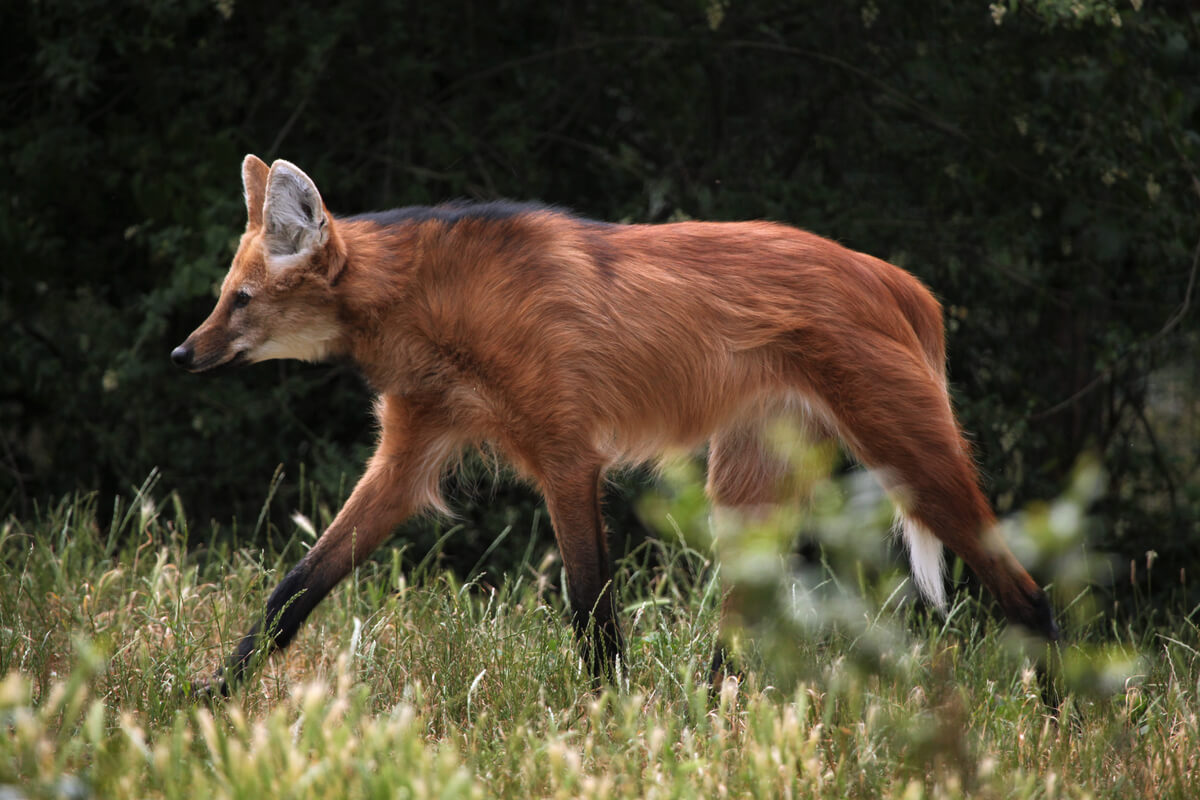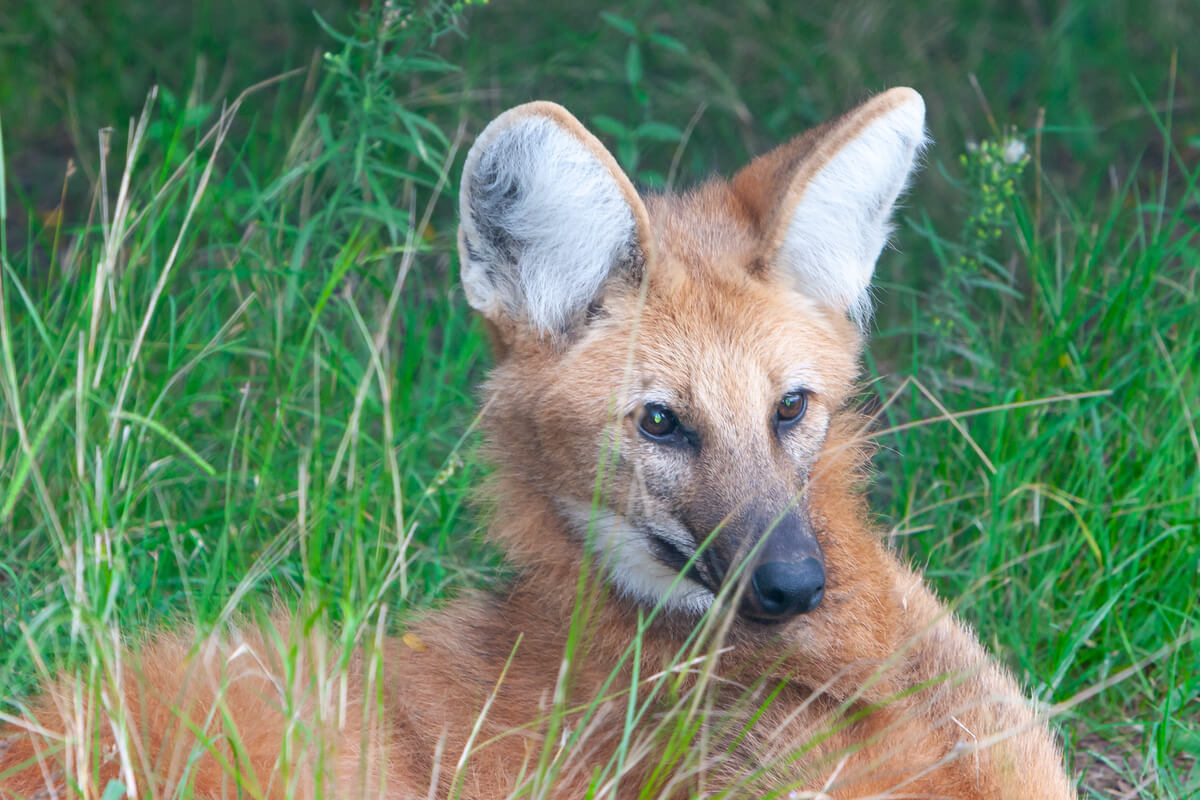9 Curiosities About the Maned Wolf


Written and verified by the biologist Cesar Paul Gonzalez Gonzalez
The maned wolf is one of the most interesting wild canids in South America. Its appearance is very similar to that of a fox, with the great difference being that its fur is denser and its body larger. On average, these animals measure one meter in height (3.3 feet) at the withers and at least 120 centimeters (nearly 4 feet) in length.
The scientific name of this species is Chrysocyon brachyurus. Some people think that it’s simply a large fox. Continue reading this space and discover some curiosities about the maned wolf.
Unique facts about the maned wolf
This species has a rather limited area of distribution, so not many people know about this peculiar canid. Listed below are some of the most interesting facts about the maned wolf.
1. It isn’t closely related to foxes
Although its appearance is identical to that of a fox, the phylogenetic relationships of the maned wolf make it closer to wolves. However, technically speaking it isn’t either a wolf or a fox. Its genus actually means “golden dog”.
2. They aren’t so sociable
Canids are a group characterized by being sociable and creating packs to move together. However, this species breaks the rule, as they live solitary lives and only meet other specimens during the breeding season.

3. It isn’t dangerous to humans
Despite its imposing presence, the maned wolf isn’t very aggressive and isn’t a danger to humans. In fact, they don’t usually pose a risk to livestock either, as they prefer smaller prey and don’t dare to enter villages. However, many people are afraid of them just because of their appearance.
4. It’s the largest canid in South America
Among all canids, the maned wolf is considered the largest in South America.
5. It doesn’t like meat very much
Most canids have a certain predilection for eating meat. However, the maned wolf is an animal prefers to eat fruits and tender roots. Much of the nutrients in its diet are of vegetable origin, but it can also hunt and stalk prey like any other canid.
6. They have only one partner (they’re monogamous)
This species is monogamous and keeps the same partner throughout its life. However, even though they’re a couple, they don’t live together nor do they spend much time together, and each one follows the solitary life that characterizes this canid. The most they do is to live together in the same territory divided into equal parts for each one.
7. They’ve adapted to living in grasslands
Grasslands are ecosystems with large extensions of medium or tall grass, which is perfect for the life of several rodents, reptiles, and amphibians. However, these areas are also ideal for a long-legged and sensitive-eared canid such as the maned wolf. With these characteristics, it’s able to perceive the movement of prey and chase them through the area with great agility and speed.

8. The coloration of the cubs is different from that of the adults
The maned wold has orange fur with some black patches on its legs and back, as well as contrasting light tones on its belly and face. Although this appearance is unique to the species, cubs under 3 months of age have a light gray coloration throughout their body. This seems to be an adaptation to be unnoticed by predators, as their fur changes color as they grow.
9. It is a protected species
Despite being a beautiful species, the maned wolf is classified and protected by several South American governments. The destruction of its habitat, illegal trade, and its capture to be used as pets have caused its population to decrease.
For this reason, several conservation programs and policies have been formalized in an attempt to rescue the species. Thus, at present, in more than 85% of its distribution area, it’s illegal to capture, hunt or trade the maned wolf.
As you can see, the maned wolf is an interesting species with some fascinating characteristics. It’s a real pity that it’s a threatened species, because its beauty goes more than skin deep. This is just one more example of what over-consumption and prejudice can do to such a charismatic animal.
All cited sources were thoroughly reviewed by our team to ensure their quality, reliability, currency, and validity. The bibliography of this article was considered reliable and of academic or scientific accuracy.
- Hammond, E. E. (2011). Medical management of maned wolves (Chrysocyon brachyurus). Fowler’s Zoo and Wild Animal Medicine Current Therapy, 7, 451-457.
- Muzzachiodi, N. (2015). Amenazas locales. Acciones desarrolladas, en desarrollo y perspectivas de conservación en las provincias. ENTRE RIOS. En Orozco, María Marcela, Gonzalez Ciccia, Paula y Soler, Lucía, Estado de conservación del aguará guazú (Chrysocyon brachyurus) en la Argentina. Buenos Aires (Argentina): Fundación de Historia Natural Félix de Azara Depar.
- Padilla, L. R., & Hilton, C. D. (2015). Canidae. Fowler’s Zoo and Wild Animal Medicine, Volume 8, 457.
- Gittleman, J. L. (2013). Carnivore behavior, ecology, and evolution. Springer Science & Business Media.
This text is provided for informational purposes only and does not replace consultation with a professional. If in doubt, consult your specialist.